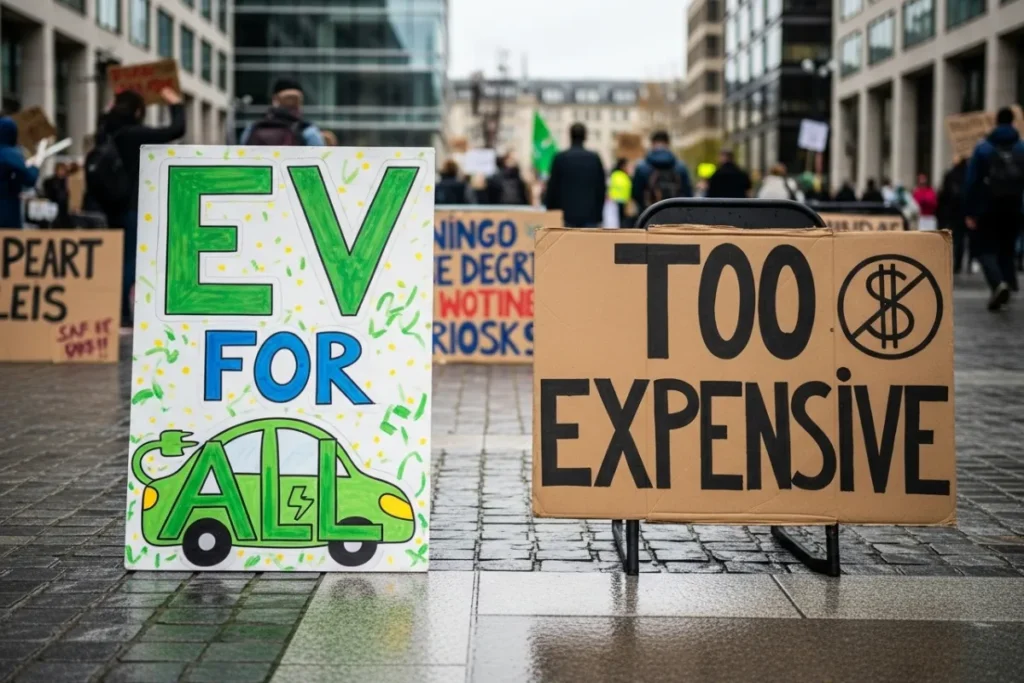Explore the complex intersection of electric car politics, environmental sustainability, and social justice. This blog delves into the evolution of electric vehicle legislation, the challenges of equitable access for marginalized communities, and current trends driving the transition to electric mobility. We discuss the impact of EV subsidies and the necessity for inclusive policies that foster fair access to green transportation options. Understand how public policy shapes consumer behavior and addresses climate change, all while ensuring that the benefits of electric vehicles extend to all demographics. Stay informed on the future challenges and opportunities in electric car politics.
Table of Contents
Introduction to Electric Car Politics
The emergence of electric vehicles (EVs) has dramatically transformed discussions surrounding transportation regulation and environmental sustainability. Within the realm of electric car politics, a complex interplay occurs between green vehicle legislation and social justice, as these topics shape public policy and consumer behavior. As society grapples with the pressing realities of climate change, the acceptance and adoption of EVs hinge not only on technological innovations but also on how policies are crafted and implemented at various governmental levels.
Electric mobility regulations are crucial in setting the framework within which the EV market operates. These regulations encompass a range of components, such as emissions standards, production incentives, and charging infrastructure investments. Such policies are designed to drive the transition towards clean energy alternatives while also addressing broader concerns about equity, accessibility, and social justice. Particularly, the discourse around EV policy equity reflects the need to ensure that all demographics benefit from the shift toward greener transportation options, rather than deepen existing socioeconomic divides.
Moreover, the debates surrounding EV subsidies illustrate the tension between economic viability and environmental responsibility. Policymakers are increasingly tasked with considering not only the financial implications of these incentives but also their impact on marginalized communities. The relationship between green vehicle legislation and social justice often brings forth questions about who really benefits from EV subsidies, challenging the notion that all sectors of society can equally participate in the electric mobility revolution.
As public awareness grows and activism influences political arenas, the landscape of electric car politics will continue to evolve. Navigating these issues requires a nuanced understanding of their interplay, underscoring how electric vehicle policies encapsulate broader discussions about environmental justice, economic equity, and sustainable development.
Historical Context of Electric Car Legislation
The evolution of Electric Car Politics has undergone significant transformation over the past few decades, influenced by a combination of technological advancements, environmental concerns, and societal demands for social justice. The historical development of these policies began in earnest in the early 1990s when California introduced its Zero Emission Vehicle (ZEV) mandate. This was one of the first legislative efforts aimed at limiting emissions from vehicles and promoting green vehicle legislation as a means to combat air pollution.
As climate change became a more pressing global issue, the late 1990s and early 2000s saw a surge in international interest in electric mobility regulations. Countries across the globe began to implement local laws encouraging the adoption of EVs. For instance, the introduction of tax incentives for electric vehicle buyers, rebates, and funding for charging infrastructure helped shape the landscape of electric mobility. Notably, the U.S. government’s federal tax credit for electric vehicles in 2009 significantly spurred demand, illustrating how EV subsidy debates can influence consumer choices and market dynamics.
In addition to economic incentives, initiatives aimed at promoting social justice and equity related to EV access have also gained prominence. Advocacy for equitable policies has highlighted the importance of ensuring that low-income communities benefit from the transition to electric vehicles. Policymakers began to recognize that the benefits of electric mobility should not only serve affluent populations but should also extend to marginalized groups who often bear the brunt of pollution.
The timeline of electric car policies reveals a complex interplay between regulatory efforts, market forces, and the societal implications of transitioning to electric mobility. As legislation continues to evolve, it remains crucial to examine the motivations behind such policies and their impact on social equity. By understanding the historical context of these developments, stakeholders can better navigate the current and future landscape of electric vehicle legislation.

Current Trends in EV Policy and Legislation
The landscape of Electric Car Politics and legislation is rapidly evolving as governments worldwide prioritize sustainability and the reduction of carbon emissions. In recent years, numerous states and countries have enacted legislation to promote electric mobility and facilitate the transition from fossil fuel-based transportation to greener alternatives. Central to this transformation are various incentive programs, tax breaks, and subsidies aimed at encouraging both manufacturers and consumers to adopt electric vehicles.
At the federal level, initiatives such as the restructured EV subsidy debates have gained traction, focusing on equitable access to electric vehicles across different socioeconomic groups. This aspect of EV policy equity seeks to ensure that low-income communities do not bear the brunt of the financial implications associated with the shift to electrification, thereby promoting social justice and EVs. By providing financial incentives, such as tax credits and rebates, these policies aim to make EVs more affordable while achieving broader environmental goals.
On a state-by-state basis, we observe a variety of green vehicle legislation tailored to regional needs. For instance, several states have implemented policies that encourage utility companies to invest in charging infrastructure, enhancing the accessibility of EVs. Additionally, certain states are setting ambitious targets aimed at reducing greenhouse gas emissions, in alignment with national clean energy policies. Such regulations not only demonstrate a commitment to environmental stewardship but also foster a competitive marketplace for electric vehicles, resulting in further innovation and consumer choice.
The shift toward electric mobility is not merely technological but deeply intertwined with societal considerations. Policymakers must balance the advancement of green vehicle legislation with the need for inclusive access to the benefits of electric vehicles. As discussions on policies and incentives continue, it remains essential to evaluate the implications of these legislations on various demographics while steering the overall drive to a sustainable future.
Equity and Access in Electric Car Politics
The emergence of electric vehicle (EV) technology has brought forth a variety of beneficial opportunities, yet it also raises significant equity concerns in its implementation and accessibility. The dichotomy between green vehicle legislation and social justice manifests as marginalized communities frequently facing barriers in accessing electric mobility options. This inequity can be attributed to various socioeconomic factors, including income disparities, geographic location, and limited infrastructure for electric vehicles in lower-income areas.
As government bodies draft and enact Electric Car policies, the challenge lies in ensuring that these regulations do not inadvertently widen the gap between different social strata. For example, while EV subsidy debates focus on providing financial incentives for consumers to adopt electric cars, the distribution of these subsidies can often favor affluent individuals who can afford to purchase new EVs. Consequently, the intended benefits of cleaner air and reduced greenhouse gas emissions may overlook low-income families, effectively sidelining them from the green revolution in transportation.
To address these growing concerns, inclusivity must be at the forefront of electric mobility regulations. Policymakers should prioritize initiatives that foster equitable access to EVs, such as incentives tailored towards low-income households, investments in charging infrastructure in underserved areas, and education programs that raise awareness about the environmental and economic benefits of electric mobility. By promoting equity through targeted policies, we can ensure that all communities, particularly those historically marginalized, have equal opportunities to benefit from the transition to electric vehicles.
Ultimately, achieving true equity in electric car politics necessitates a collaborative effort among stakeholders, including the government, the private sector, and community organizations. Recognizing that the path to sustainability must also champion social justice is essential in creating a future where access to EV technology is equitable for all.

Impact of Electric Car Politics on Marginalized Communities
Electric Car Politics present both challenges and opportunities for marginalized communities. Analyzing the impact of electric car policies reveals significant disparities in access to electric mobility and the potential implications for social justice. Current green vehicle legislation often prioritizes affluent segments of society, which can inadvertently deepen existing inequalities. For instance, the availability of incentives and subsidies for electric vehicles frequently skews toward higher-income households, leaving low-income populations with limited access to these benefits.
One major barrier is the higher upfront cost associated with electric vehicles. While EV subsidy debates have introduced financial incentives aimed at bridging this gap, the effectiveness of these programs can vary greatly across demographics. Low-income households may not have the creditworthiness to secure financing for an electric vehicle, thus limiting their participation in the transition to cleaner transportation options. Furthermore, the lack of public charging infrastructure in underserved areas exacerbates these challenges, dissuading further investment in EVs and perpetuating reliance on conventional vehicles.
Conversely, certain policies can create opportunities for marginalized communities. For instance, some states have implemented programs specifically aimed at increasing access to electric mobility within disenfranchised demographics. These initiatives often include expanding charging networks in urban centers and offering tailored subsidies for lower-income drivers. Such measures can enhance social equity by promoting broader access to electric vehicles, thereby contributing to the overall aim of a sustainable transportation system. However, it is critical to evaluate the long-term sustainability and inclusivity of these policies to ensure that they do not merely serve as a temporary remedy.
In conclusion, understanding the intersectionality of electric mobility regulations and marginalized communities can lead to more equitable electric car politics. It is essential to continue addressing barriers while leveraging opportunities within the electric car sector to promote social justice and environmental sustainability.
Case Studies of Social Justice in EV Initiatives
The intersection of electric car politics and social justice has gained increasing attention as governments and organizations devise green vehicle legislation aimed at promoting sustainable transportation. A notable case is the California Clean Vehicle Rebate Project, which offers significant subsidies to individuals purchasing EVs. However, critiques have surfaced concerning inequities in access to these benefits, particularly among low-income households and underrepresented communities. Although the program has successfully increased electric vehicle adoption, its structure necessitated revisions to ensure equitable distribution of subsidies, demonstrating the importance of inclusive electric mobility regulations.
Conversely, New York City’s initiative, “ChargeNY,” aimed at creating a robust EV infrastructure while prioritizing social equity, serves as an exemplary case study. By collaborating with community groups, the city ensured that charging stations were installed in neighborhoods that traditionally lacked access to EV resources. This collaborative approach not only expanded availability but also educated residents about electric car politics and benefits, contributing to an informed and engaged public. The focus on education and infrastructure access significantly narrowed the equity gap observed in similar programs, establishing a model for future initiatives.
Another example can be drawn from the EV subsidy debates in various European countries, where policymakers struggled with balancing incentives. In Norway, government efforts led to nearly 50% of new car sales becoming electric, fueled by significant tax exemptions and policy support. However, the stratification of ownership raised concerns regarding social justice, as wealthier individuals disproportionately benefited from the incentives. To rectify this, Norway’s government has continually adapted its subsidy frameworks to foster inclusive access while ensuring that lower-income citizens can participate in the transition towards electric mobility.

Green Vehicle Legislation and Environmental Justice
The intersection of green vehicle legislation and environmental justice represents a critical discourse in contemporary policy-making. Green vehicle legislation primarily aims to facilitate the adoption of electric vehicles (EVs), significantly contributing to the reduction of greenhouse gas emissions and fostering environmental sustainability. However, an equitable approach in formulating these policies is essential to ensure that all communities, particularly marginalized ones, benefit from the advantages of electric mobility.
Environmental justice advocates highlight the disparities these policies can inadvertently create. For instance, while electric mobility regulations may lead to cleaner air and reduced emissions, they often do not address the socioeconomic barriers that prevent low-income households from accessing EVs. These groups benefit the least from subsidies or tax incentives associated with green vehicle initiatives, leading to broader discussions in EV subsidy debates about the accessibility and affordability of electric cars. Solutions must be sought that align electric car policy with social justice imperatives.
Moreover, integrating the principles of social justice into electric car politics, frameworks involves recognizing the historical injustices faced by marginalized communities. Policymakers must implement strategies that not only incentivize the purchase and use of green vehicles but also promote infrastructure development in underserved areas. This includes expanding charging stations, offering financial assistance for EV purchases, and investing in public transportation alternatives that utilize electric technology.
Ultimately, the success of green vehicle legislation hinges on its ability to be inclusive. Stakeholders must engage with community members to identify their unique needs, ensuring that efforts to promote electric mobility do not overlook the necessity of equitable access. By prioritizing environmental justice within the context of electric car politics, we can pave the way for a sustainable and socially responsible transportation future.
Debates Surrounding Electric Car Subsidies
The conversation around electric vehicle (EV) subsidies is increasingly prominent in the realm of green vehicle legislation and electric mobility regulations. Proponents argue that subsidies are essential for fostering the transition to cleaner transportation, particularly in light of the urgent need to combat climate change. These advocates contend that financial incentives for electric vehicles can stimulate consumer demand, advance technological innovation, and ultimately reduce greenhouse gas emissions. Countries that have implemented robust EV subsidy programs often experience accelerated growth in electric mobility and a more significant adoption of sustainable practices.
On the other side of the debate, critics of EV subsidies point to issues of equity and social justice. They argue that these financial incentives disproportionately benefit wealthier households, as electric vehicles typically come with a higher sticker price. This raises concerns about the fairness of a system where subsidized EVs may not be accessible to lower-income individuals. Critics assert that the subsidies may exacerbate existing inequities if policies fail to include provisions that enhance access for disadvantaged communities. The disparities in purchasing power and geographical location can create barriers to achieving the environmental goals underpinning these subsidies.
Furthermore, the ongoing discussions regarding EV policy equity highlight the necessity for a more inclusive approach toward the electrification of transportation. Ensuring that various socio-economic groups can participate in and benefit from the transition to electric mobility is crucial for advancing social justice in this context. Therefore, policymakers must consider the broader implications of EV subsidy debates and explore innovative solutions that promote equitable access to both electric vehicles and charging infrastructure. Balancing environmental priorities with social equity will be key to establishing a sustainable future in electric mobility.
| Perspective | Main Arguments | Implications / Concerns |
|---|---|---|
| Proponents of EV Subsidies | – Essential to drive uptake of cleaner transport- Stimulate consumer demand- Advance innovation- Reduce GHG emissions | – Accelerated electric mobility growth- Faster adoption of sustainable practices |
| Critics of EV Subsidies | – Benefit wealthier households disproportionately- EVs have higher sticker prices- May widen equity gaps | – Lower-income groups left out- Risk of exacerbating social and geographic divides |
| Policy Recommendations | – Adopt inclusive subsidy designs- Ensure access for disadvantaged communities- Expand charging infrastructure equitably | – Balance environmental goals with social justice- Promote truly sustainable transition |
Future of Electric Car Politics: Challenges and Opportunities
The landscape of electric car politics is rapidly evolving, shaped by a multitude of factors including emerging technologies and societal shifts. One significant challenge facing the future of electric mobility regulations is the equitable distribution of EV benefits. As various governments implement green vehicle legislation, the need for a balanced approach to accessibility becomes apparent. For instance, without careful planning, subsidies and incentives may disproportionately favor affluent consumers, raising concerns about social justice and the real impact of such measures on lower-income populations.
Public opinion is also shifting, with increasing numbers of individuals advocating for environmental sustainability and equitable access to EVs. This growing awareness opens avenues for meaningful policy reforms aimed at enhancing equity in EV access. Legislative initiatives could include inclusive subsidy frameworks designed to ensure that all socio-economic groups can participate in the transition to electric mobility. Furthermore, engaging community stakeholders in the policy-making process can help create a more just and holistic approach to EV policy equity, where the benefits of electric vehicles are accessible to all.
Emerging technologies present both opportunities and challenges in this domain. Innovations in battery technology and charging infrastructure can lower costs and improve the overall viability of EVs. However, ensuring that these advancements benefit marginalized communities is crucial. As electric mobility regulations continue to evolve, stakeholders must navigate debates surrounding EV subsidies, ensuring they promote equitable outcomes. A focus on sustainable policies that address both environmental goals and social implications will be vital as society moves towards an environmentally friendly future.
As the electric car industry matures, it faces a dual imperative: advancing technology while simultaneously addressing the realities of social justice. Balancing these demands will ultimately define the future trajectory of electric car politics.




